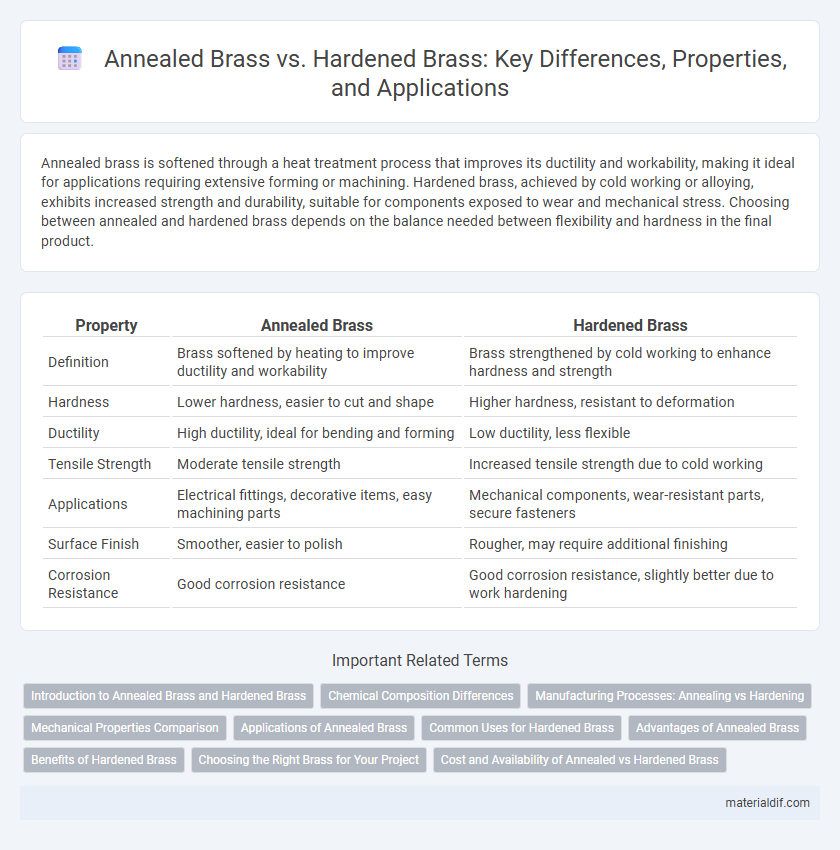Annealed brass is softened through a heat treatment process that improves its ductility and workability, making it ideal for applications requiring extensive forming or machining. Hardened brass, achieved by cold working or alloying, exhibits increased strength and durability, suitable for components exposed to wear and mechanical stress. Choosing between annealed and hardened brass depends on the balance needed between flexibility and hardness in the final product.
Table of Comparison
| Property | Annealed Brass | Hardened Brass |
|---|---|---|
| Definition | Brass softened by heating to improve ductility and workability | Brass strengthened by cold working to enhance hardness and strength |
| Hardness | Lower hardness, easier to cut and shape | Higher hardness, resistant to deformation |
| Ductility | High ductility, ideal for bending and forming | Low ductility, less flexible |
| Tensile Strength | Moderate tensile strength | Increased tensile strength due to cold working |
| Applications | Electrical fittings, decorative items, easy machining parts | Mechanical components, wear-resistant parts, secure fasteners |
| Surface Finish | Smoother, easier to polish | Rougher, may require additional finishing |
| Corrosion Resistance | Good corrosion resistance | Good corrosion resistance, slightly better due to work hardening |
Introduction to Annealed Brass and Hardened Brass
Annealed brass is a type of brass alloy that has undergone a heat treatment process to enhance its ductility and reduce hardness, making it easier to machine, bend, and form. Hardened brass, in contrast, results from work hardening or cold working, which increases its strength and resistance to wear but reduces its flexibility. These properties make annealed brass ideal for applications requiring malleability, while hardened brass is preferred in environments demanding durability and structural integrity.
Chemical Composition Differences
Annealed brass typically contains higher percentages of copper and zinc with minimal additions of lead or other alloying elements, allowing increased ductility and softness through heat treatment. Hardened brass often includes small amounts of tin, manganese, or iron to enhance strength and hardness while maintaining corrosion resistance. The chemical composition differences directly influence the mechanical properties, with annealed brass favoring malleability and hardened brass optimized for durability.
Manufacturing Processes: Annealing vs Hardening
Annealed brass undergoes a controlled heating and gradual cooling process that softens the alloy, enhancing its ductility and workability for forming and machining applications. Hardened brass is produced through work hardening or heat treatment methods that increase the material's strength and resistance to wear by altering its microstructure. The annealing process reduces internal stresses, while hardening optimizes mechanical properties for demanding industrial uses.
Mechanical Properties Comparison
Annealed brass exhibits lower tensile strength and higher ductility, making it more malleable and easier to form in manufacturing processes. Hardened brass offers increased hardness and tensile strength due to work hardening, enhancing its resistance to wear and deformation under mechanical stress. The choice between annealed and hardened brass depends on the application's need for flexibility versus durability and load-bearing capacity.
Applications of Annealed Brass
Annealed brass is widely used in applications requiring enhanced malleability and ductility, such as intricate metalwork, tubing, and decorative items. Its softened state allows for easy shaping and machining, making it ideal for electrical connectors, plumbing fittings, and musical instruments. The superior corrosion resistance and excellent thermal conductivity of annealed brass also contribute to its preference in heat exchangers and marine hardware.
Common Uses for Hardened Brass
Hardened brass is commonly used in applications requiring enhanced strength and wear resistance, such as ammunition casings, roofing nails, and electrical connectors. Its improved hardness makes it suitable for mechanical components subjected to high stress, including gears and valves. The material's durability ensures reliable performance in demanding industrial environments.
Advantages of Annealed Brass
Annealed brass offers superior ductility and malleability, making it ideal for complex forming and machining processes. Its enhanced softness reduces the risk of cracking and stress during bending or stamping, resulting in higher-quality finished products. This material also provides excellent corrosion resistance and electrical conductivity, beneficial for various industrial and decorative applications.
Benefits of Hardened Brass
Hardened brass offers superior durability and resistance to wear compared to annealed brass, making it ideal for applications requiring high strength and longevity. Its enhanced hardness improves performance in mechanical components such as valves, gears, and fasteners, reducing the risk of deformation under stress. The increased resilience of hardened brass also provides better corrosion resistance, extending the lifespan of parts in harsh environments.
Choosing the Right Brass for Your Project
Annealed brass offers enhanced malleability and ease of machining, making it ideal for intricate designs and detailed fabrication processes. Hardened brass provides superior strength and wear resistance, suitable for components subjected to high stress or friction. Selecting the right brass depends on balancing flexibility requirements with durability demands specific to your project's application.
Cost and Availability of Annealed vs Hardened Brass
Annealed brass generally costs less than hardened brass due to its softer structure and easier manufacturing process, which also leads to wider availability in the market. Hardened brass, produced through cold working or heat treatment to increase strength, is often pricier and may have more limited stock due to specialized production requirements. Procurement of annealed brass suits applications needing formability and lower expense, while hardened brass is preferred for durability despite higher cost and sometimes reduced availability.
Annealed Brass vs Hardened Brass Infographic

 materialdif.com
materialdif.com